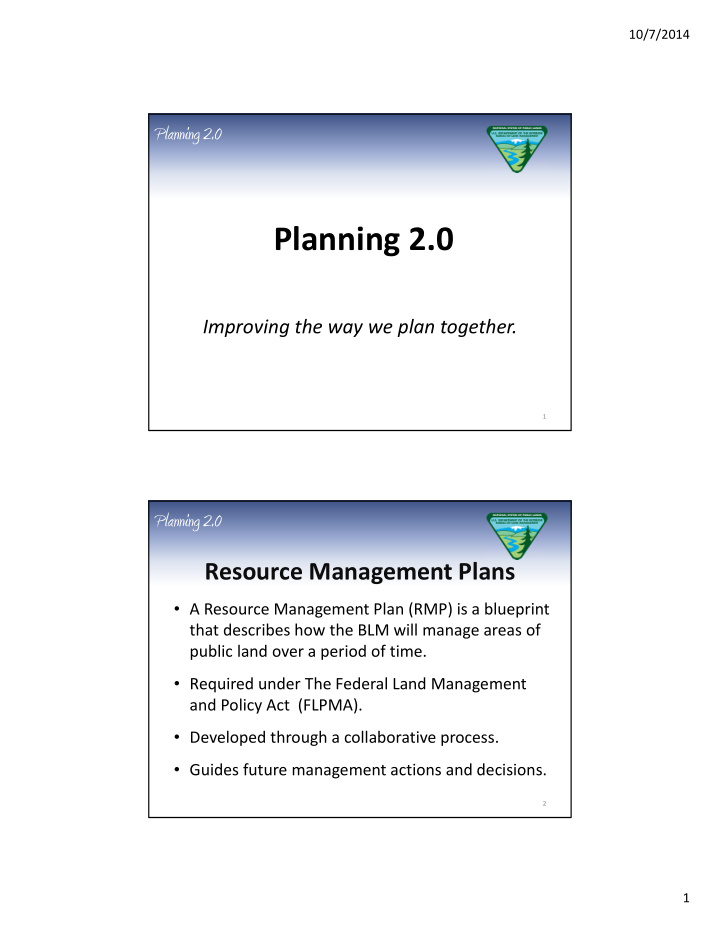



10/7/2014 Planning 2.0 Planning 2.0 Improving the way we plan together. 1 Planning 2.0 Resource Management Plans • A Resource Management Plan (RMP) is a blueprint that describes how the BLM will manage areas of public land over a period of time. • Required under The Federal Land Management and Policy Act (FLPMA). • Developed through a collaborative process. • Guides future management actions and decisions. 2 1
10/7/2014 Planning 2.0 Planning Status • 50+ on ‐ going Resource Management Plans (RMPs) under development. • Most western states include 6 ‐ 10 planning areas. 3 Planning 2.0 How did this initiative get started? 2016 Roadmap for Success Develop a more proactive and nimble approach to planning. http://www.blm.gov/wo/st/en/info/directors_corner/2016roadmap.html 4 2
10/7/2014 Planning 2.0 Internal Assessment • Overview of BLMs Current Planning Process • Litigation review • Recommendations 5 Planning 2.0 The Landscape Approach • Landscape scale assessments • Regional mitigation strategies • Monitoring for adaptive management • Geospatial data integration • Science integration Planning 2.0 will improve our ability to “plan across landscapes” 6 3
10/7/2014 Planning 2.0 Project Goals 1. Create a more dynamic and efficient planning process. 2. Enhance opportunities for collaborative planning. 3. Plan across landscapes and at multiple scales. 7 Planning 2.0 Project Steps Spring 2015 Spring 2016 Final Proposed Rule Rule Identify Implement Potential Changes Changes Draft Final Handbook Handbook Summer 2015 Summer 2016 We are here! 8 4
10/7/2014 Planning 2.0 How might we meet these goals? 9 Planning 2.0 Create a more dynamic and efficient planning process 1. Integration of adaptive management into plans. 2. Earlier public and stakeholder collaboration. 3. Improved amendment process. 10 5
10/7/2014 Planning 2.0 Enhance opportunities for collaborative planning. 1. New opportunities for public participation and stakeholder collaboration. 2. Improved use of web technology. 3. Continue to actively engage Cooperating Agencies in plan development. 11 Planning 2.0 Plan across landscapes and at multiple scales 1. Reconsider boundaries for future plans. 2. Higher ‐ level plans are focused on landscape goals and land use allocations. 3. Emphasis on geospatial data ‐ driven plans. 12 6
10/7/2014 Planning 2.0 What could this process look like? 13 Planning 2.0 Conceptual Planning Decision Frameworks Current RMPs Integrated RMP Structured by Programs Landscape Approach Program Program Program Landscape Goal Goal Goal Goals Objective 1 Objective 1 Objective 1 Integrated Objective 2 Objective 2 Objective 2 Objective 3 Objective 3 Objective 3 Objectives Allowable Allowable Allowable Allowable Allowable Allowable Use & Use & Use & Use & Use & Use & Management Management Management Management Management Management Actions Actions Actions Actions Actions Actions Required Required Required Regional Mitigation Design Design Design Required Design Features Features Features Features 14 7
10/7/2014 Planning 2.0 Current Planning Process* RMP Development RMP Review Notice Notice of Availability of Intent for Draft Plan Public Comment Public Period Scoping Revise Plan Assess the Management Notice of Availability Situation for Proposed Plan Protest and Develop Governors Alternatives Consistency Review Prepare Draft Plan Publish Final Decision 15 *For new plans and revisions Planning 2.0 Possible Revised Process* Pre ‐ Planning RMP Development RMP Review Evaluate Existing Notice Notice of Availability Management and of Intent for Draft Plan Need for a Plan Revision Public Public Scoping Comment Period Pre-Planning Formulate Outreach Revise Plan Alternatives Assess the Notice of Availability Management Alternatives for Proposed RMP Situation Outreach Protest Period and Revise Governors Alternatives Consistency Review Prepare Draft Plan Publish Final Decision *For new plans and revisions 16 8
10/7/2014 Planning 2.0 PRE ‐ PLANNING BLM evaluates existing management and management concerns. • Is existing management working? • Are there resource management concerns? • What is the anticipated scope of the planning effort? • What is the anticipated planning area boundary? 17 PRE ‐ PLANNING Planning 2.0 Collaborative pre ‐ planning outreach. • What resources and multiple uses are important in the planning area? • Where are they important? • What is our long ‐ term vision for the landscape? • Is the planning area boundary and scope of the planning effort appropriate to reach this vision? • What data is available for this planning effort? 18 9
10/7/2014 Planning 2.0 PRE ‐ PLANNING Data gathering informs scoping. Plan Evaluation Ecoregional Assessments Assessment Data from Public Scoping Cooperators Monitoring Data Other Data Sources (e.g. Citizen Science) 19 RMP DEVELOPMENT Planning 2.0 Alternatives outreach. • Is the range of alternatives complete? • Is any relevant information missing? • Are the goals consistent with each other? 20 10
10/7/2014 Planning 2.0 How is this approach different? 1. Collaborative pre ‐ planning and alternatives outreach. 2. More focused plans. 3. Landscape ‐ level goals/direction and integrated resource and use objectives. 4. Less prescriptive plans. 5. Adaptive management. 21 Planning 2.0 Questions? 22 11
10/7/2014 Planning 2.0 Questions for Discussion • Do you have ideas on how the BLM might achieve the project goals? • What have you seen that worked well in past planning efforts? 23 12
Recommend
More recommend